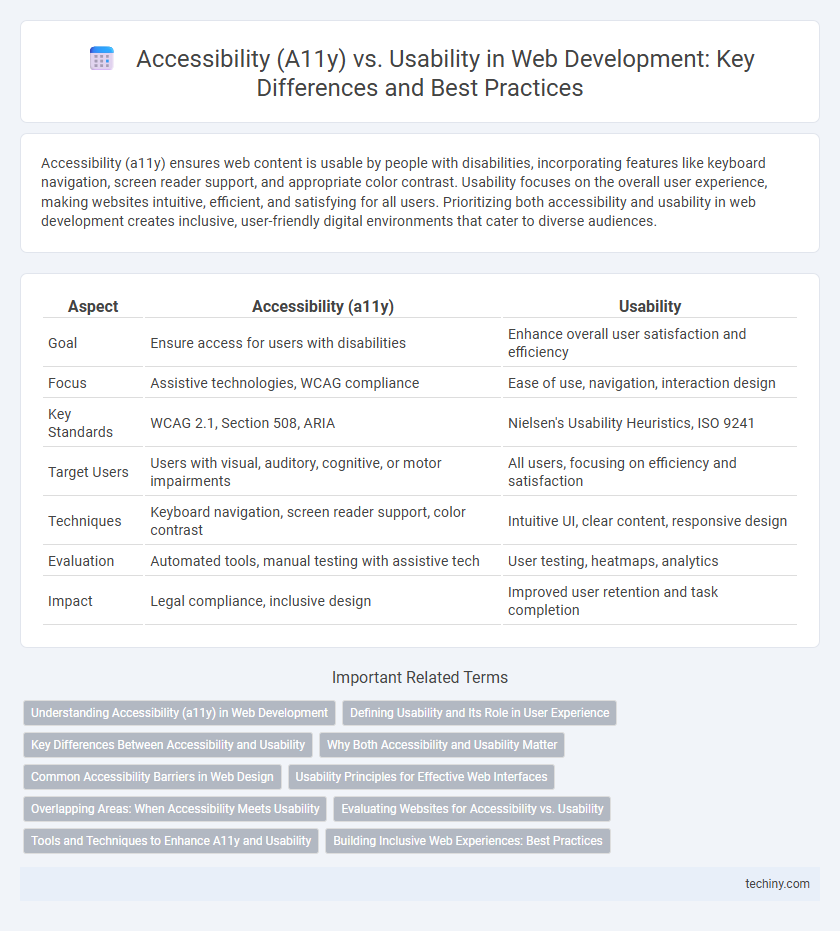Accessibility (a11y) ensures web content is usable by people with disabilities, incorporating features like keyboard navigation, screen reader support, and appropriate color contrast. Usability focuses on the overall user experience, making websites intuitive, efficient, and satisfying for all users. Prioritizing both accessibility and usability in web development creates inclusive, user-friendly digital environments that cater to diverse audiences.
Table of Comparison
| Aspect | Accessibility (a11y) | Usability |
|---|---|---|
| Goal | Ensure access for users with disabilities | Enhance overall user satisfaction and efficiency |
| Focus | Assistive technologies, WCAG compliance | Ease of use, navigation, interaction design |
| Key Standards | WCAG 2.1, Section 508, ARIA | Nielsen's Usability Heuristics, ISO 9241 |
| Target Users | Users with visual, auditory, cognitive, or motor impairments | All users, focusing on efficiency and satisfaction |
| Techniques | Keyboard navigation, screen reader support, color contrast | Intuitive UI, clear content, responsive design |
| Evaluation | Automated tools, manual testing with assistive tech | User testing, heatmaps, analytics |
| Impact | Legal compliance, inclusive design | Improved user retention and task completion |
Understanding Accessibility (a11y) in Web Development
Understanding accessibility (a11y) in web development involves designing websites that are usable by people with diverse disabilities, ensuring compatibility with assistive technologies like screen readers and keyboard navigation. This focus goes beyond usability, which emphasizes ease of use for the average user, by addressing barriers faced by individuals with visual, auditory, motor, or cognitive impairments. Implementing semantic HTML, ARIA roles, and text alternatives is essential for creating inclusive web experiences that meet WCAG guidelines and legal standards.
Defining Usability and Its Role in User Experience
Usability in web development refers to how easily users can navigate, understand, and interact with a website or application, emphasizing efficiency, effectiveness, and user satisfaction. It plays a critical role in user experience by ensuring tasks are completed with minimal effort and errors, directly impacting user retention and engagement. While accessibility focuses on making content usable for people with disabilities, usability optimizes the overall interaction for all users, creating a seamless experience.
Key Differences Between Accessibility and Usability
Accessibility (a11y) ensures that web content is perceivable and operable for users with disabilities by adhering to standards like WCAG, focusing on assistive technologies such as screen readers and keyboard navigation. Usability emphasizes the overall user experience for all users, targeting intuitive design, ease of navigation, and efficient task completion. The key differences lie in accessibility's legal and technical compliance requirements while usability concentrates on user satisfaction and interaction efficiency.
Why Both Accessibility and Usability Matter
Accessibility (a11y) ensures that web content is perceivable and operable by people with disabilities, while usability focuses on the overall ease of navigation and user satisfaction for all users. Both accessibility and usability improve user experience by removing barriers to information and functionality, increasing engagement and retention. Websites optimized for a11y and usability achieve wider reach, compliance with legal standards, and enhanced performance across diverse devices and user contexts.
Common Accessibility Barriers in Web Design
Common accessibility barriers in web design include insufficient color contrast, missing alternative text for images, and keyboard navigation issues, which hinder users with visual and motor impairments. Usability focuses on ease of use and user satisfaction but may overlook these critical accessibility requirements that ensure inclusivity. Addressing both accessibility (a11y) and usability guarantees a seamless experience for all users, including those relying on assistive technologies.
Usability Principles for Effective Web Interfaces
Usability principles for effective web interfaces emphasize intuitive navigation, consistency in design elements, and clear feedback mechanisms to enhance user satisfaction and efficiency. Prioritizing user-centered design, web developers implement responsive layouts and ensure content readability across devices to facilitate seamless interactions. These strategies reduce cognitive load, improve task completion rates, and foster inclusive digital experiences beyond basic accessibility standards.
Overlapping Areas: When Accessibility Meets Usability
Accessibility and usability intersect significantly in web development by ensuring websites are both inclusive and easy to navigate. Incorporating semantic HTML, keyboard navigation, and clear visual hierarchy enhances user experience for individuals with disabilities and the general audience alike. Optimizing these overlapping areas improves overall site functionality, engagement, and compliance with WCAG standards.
Evaluating Websites for Accessibility vs. Usability
Evaluating websites for accessibility involves ensuring all users, including those with disabilities, can perceive, navigate, and interact with web content through assistive technologies and keyboard navigation, adhering to WCAG guidelines. Usability assessment focuses on how easily and efficiently all users accomplish tasks and find information, emphasizing intuitive design, clear navigation, and responsive layouts. Both accessibility and usability testing employ metrics like error rates and task completion time but accessibility tests prioritize compliance with standards such as WCAG 2.1 to guarantee equal access.
Tools and Techniques to Enhance A11y and Usability
Effective web development integrates tools like screen readers, keyboard navigation, and ARIA roles to enhance accessibility (a11y) for users with disabilities. Usability testing techniques such as user scenario analysis and heatmaps complement a11y tools by ensuring intuitive interaction and efficient task completion. Combining automated accessibility checkers with manual audits strengthens compliance with WCAG standards while optimizing user experience across diverse devices and platforms.
Building Inclusive Web Experiences: Best Practices
Building inclusive web experiences requires prioritizing both accessibility (a11y) and usability to ensure all users, including those with disabilities, can navigate and interact effectively. Implementing semantic HTML, ARIA roles, and keyboard navigation enhances accessibility, while user-centered design and intuitive interfaces improve overall usability. Continuous testing with diverse user groups and adherence to WCAG guidelines maximize inclusivity and user satisfaction.
Accessibility (a11y) vs Usability Infographic

 techiny.com
techiny.com